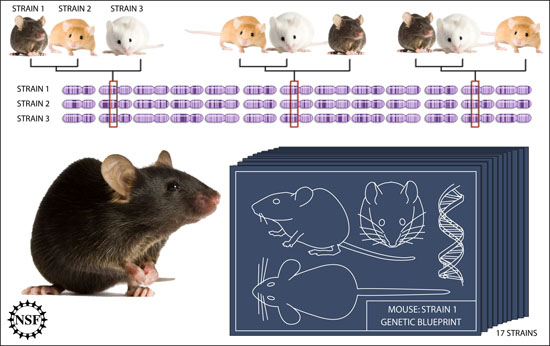Mouse genome sequences reveal variability, complex evolutionary history
The genome of even a single organism is packed with information. A new paper, building on recent advances in sequencing capability, now reports the complete genomes of 17 different strains of mice, creating an unparalleled genetic resource that will aid studies ranging from human disease to evolution.
An international team of researchers, including University of Wisconsin–Madison geneticist Bret Payseur, describe in the Sept. 14 issue of the journal Nature the genome sequencing and comparison of 17 mouse strains, including several of the most common laboratory strains and four recently derived from wild populations. The resulting database, the largest for any vertebrate model organism, documents the range of genetic variation between mouse strains and its effects on phenotypes and gene regulation.
Comparison of the genome sequences of three mouse strains by UW–Madison geneticist Bret Payseur reveals that mice have a complex evolutionary history, with multiple possible relationships each supported by different traits.
Illustration credit: Zina Deretsky, National Science Foundation
“Mice are the premier model organism for human disease. We’ve made a lot of progress in understanding the genetics of common human diseases by studying mice,” says Payseur, an associate professor of medical genetics in the UW–Madison School of Medicine and Public Health. “Although we’ve been able to map genomic regions that contribute to disease risk, we haven’t known the full spectrum of mutations involved.”
The new genetic compendium will help researchers more quickly find the subset of sequence differences responsible for disease and other characters, he adds. The new paper identifies mutations associated with more than 700 biological traits, including diabetes and heart disease.
“We are living in an era where we have thousands of human genomes at our fingertips,” says David Adams from the Wellcome Trust Sanger Institute, who led the project. “The mouse, and the genome sequences we have generated, will play a critical role in understanding of how genetic variation contributes to disease and will lead us towards new therapies.”
In addition to advancing the use of mice as a model for human disease, Payseur says the work also advances studies of evolution, his key interest. “We were interested in the history of mice — how did mice evolve and come to be such an important organism for research?” he asks.
He and graduate student Michael White probed the evolutionary history of the lab mouse using sequences of four wild-derived mouse strains, including three common subspecies of house mice and a more distant relative. These strains represent a few million years of evolution, offering a window into the processes that drive genetic and phenotypic change.
They found that the mouse genomes do not reflect a single evolutionary story. Rather, different parts of the genome showed different patterns of relatedness. For the three wild house mouse subspecies in this study, Payseur and White found that nearly 40 percent of the sequence supported one evolutionary relationship, another 30 percent supported another and the remaining 30 percent of the DNA suggested yet a third relationship.
The complexity uncovered here should serve as a cautionary tale for studies of evolutionary relationships between organisms, which have often made inferences based on one or a few genes, Payseur says. “If you’re looking at closely related species, don’t expect to infer the species history just by looking at a handful of regions. You really have to look at a large fraction of the whole genome.”
Payseur hopes to conduct similar analyses of the other sequenced laboratory strains to begin to fill in the large gaps in existing lab mouse pedigrees. Understanding the evolution of the lab mouse will provide important genetic context for mouse studies of human disease and help other researchers choose the strain most appropriate for their research questions.
This genomic-sequencing project was supported by The Medical Research Council, U.K., and the Wellcome Trust. Payseur’s work was supported by the U.S. National Science Foundation.
More information and a larger version of the above image are available here.





